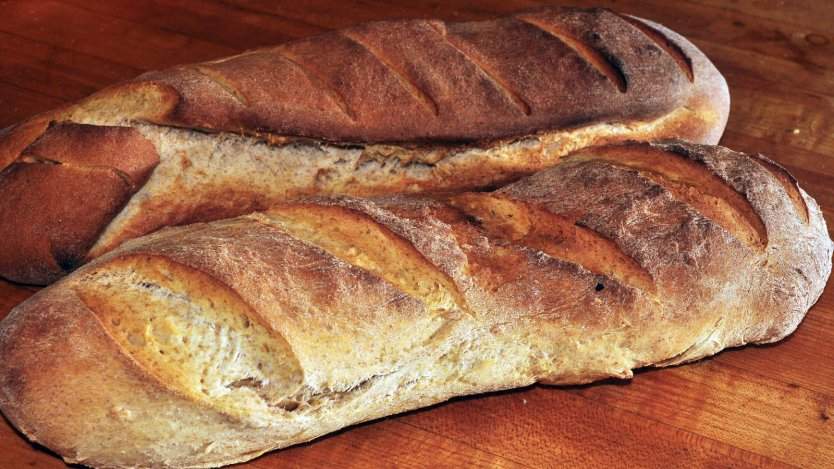For some reason, the words “homemade bread” tend to send people running. Making a fresh loaf or batch of rolls used to be common knowledge but today, may people (myself included) prefer the convenience of stopping by the local bakery or grocery store to stock up on all doughy products. Admittedly, baking bread takes time and for most, it is fairly unrealistic to try and eat solely homemade bread. Not only is it time-consuming, the whole process can be daunting, especially if you have never done it before. All it takes is one failed attempt of un-risen or over-proofed dough to convince people that they should leave bread baking to the professionals. Like many tasks, making bread consists of a series of steps. Here are the basic principles to bread making.
Measuring your ingredients
Accurately measuring your ingredients is important while baking, although bread is more forgiving than cakes or pastries, per se. In many cases, you may have to add more flour or water depending on the amount of moisture in your environment. Invest in a scale; it is more accurate and usually more convenient to measure out the base quantities. Not only is weight more accurate than cups and tablespoons, you only have to dirty one bowl as opposed to a sink full of measuring cups and spoons.
Mixing and kneading
This is where you get to get your hands dirty. Sure you can use a mixer fit with a dough hook attachment but what fun is that? Making bread is all about the feel and the only way you achieve that is by doing it by hand. The only time I prefer my mixer to my hands is with super sticky doughs like pizza or ciabatta.
As for the kneading process itself, use the counter to create some friction so the dough almost rolls back on itself as you push into it with your palm. You know it is adequately kneaded when it passes the “window pane” test. Rip off a small piece of dough and gently use your fingers to stretch it as thin as you can without tearing it. If you can get it to the point where you can see through it without there being any holes, you have done your job; if it rips, keep kneading.
Proofing – round one
After the dough is kneaded, you get some time to recuperate and rest those well-worked arms. Proofing allows the yeast to get to work, eating up the sugars in the dough. The byproduct of this is carbon dioxide gas. You know it’s there because the bread will rise as the gas causes it to expand. Depending on the temperature of your kitchen and the amount of yeast in the dough, the time this takes can really vary. Some bread only requires half an hour to double in size. Alternatively, you may have to refrigerate certain types of dough overnight to allow for slow fermentation and greater flavour development. Beware of an alcoholic smell from the dough, though. That could mean that it has over-proofed and there is no longer enough sugars for the yeast to consume.
Punching and shaping
Once the dough has risen, you have to eliminate all of the carbon dioxide by punching it down and getting all of the air bubbles out. Then you can shape it depending on the end product you are looking for. Loaves are around 500g (again this is where having a scale comes in handy). Burger buns are good at about 50g, and dinner rolls are a bit smaller at 30g. If you don’t have a scale, you can always eyeball it, keeping in mind that once the dough rises, it should be about double the size.
Proofing – round two
Now that your dough is shaped, you have to let it rise one more time before you can bake it. Otherwise your bread will be dense and heavy, without the carbon dioxide to rise and lighten it. Again, there is no set time for this to occur. However you do want to keep a few key points in mind.
First of all, always cover your dough. You don’t want it to dry out before it is even baked. Also, you know it is done proofing when you can lightly poke it with your finger and it leaves an indentation, rather than springing back. This is basically the opposite effect of knowing when a cake is done because it brings back when pressed lightly. I don’t advise poking too hard or your bread will deflate like a balloon. With that in mind, you really do not want to do anything at this point that will knock the air out of your bread. The whole point of letting it rise is to create that airiness. You don’t want to ruin that by banging the pan against the counter or jabbing it with a pastry brush.
Prepping and baking
You have kneaded it, punched it, proofed it (twice!!!) and now you are ready to bake. Which means that it is almost time to eat!
Before putting the bread in the oven, decide whether or not you want to top it with anything. Soft breads do well with a light brushing of egg wash or milk to promote browning. If you are looking for crusty bread, spritz it with water to help develop that crackly exterior. You can also add seeds, oats, cheese, etc. to top the works.
You can score loaves with a sharp, serrated knife to create designs (just don’t go too crazy because remember, we don’t want to let all of the air out). Actually, scoring does more than just make your bread look pretty. It allows for continued rising and escape of gases when baking crusty breads, and prevents them from bursting along the sides.
The temperature at which you bake the bread really depends on the type of bread you are baking. Soft breads like Pullman loaves and dinner rolls do best around 350 F as you don’t want to burn the fats and sugars in them. Leaner doughs (those with very little fat) like baguettes and focaccia can tolerate higher temperatures and are often better suited to ovens set at about 400 F or hotter to help create a crispy crust. Either way, your bread is done when it retains its shape when poked or squeezed. If you hold it by your ear and tap the bottom, it should sound relatively hollow.
Cooling and storing
All bread should be cooled on a wire rack. This allows for air circulation to dissipate the heat as quickly as possible. If you keep the bread in the pan or on the tray, it will steam and get soggy. Who wants that, especially considering that you have made it to the last step of making bread? The only caveat is that you need to allow buns or loaves cooked in pans to cool enough so that you can remove them from their pans in one piece. Just put that loaf pan on a wire rack for the time being!
Much like cooking temperature, storage is dependent on the type of bread you have made. The last thing you want to do is wrap a nice baguette in plastic and say goodbye to its crust. Store crusty breads in paper, at least until you slice them (once sliced, I wrap mine in plastic to help slow the drying process). With soft breads that don’t have much of a crust to begin with, you want to wrap them as tightly as possible so that they don’t dry out.
The great thing about homemade bread is that it does not contain a bunch of unpronounceable preservatives and you know exactly what goes into it. The unfortunate thing about homemade bread is that it does not contain a bunch of unpronounceable preservatives that help stop it from drying out. You are lucky if it lasts more than a day or two. Really, it is best eaten right out of the oven. Despite its short shelf-life, not too many things taste better than fresh, homemade bread.













